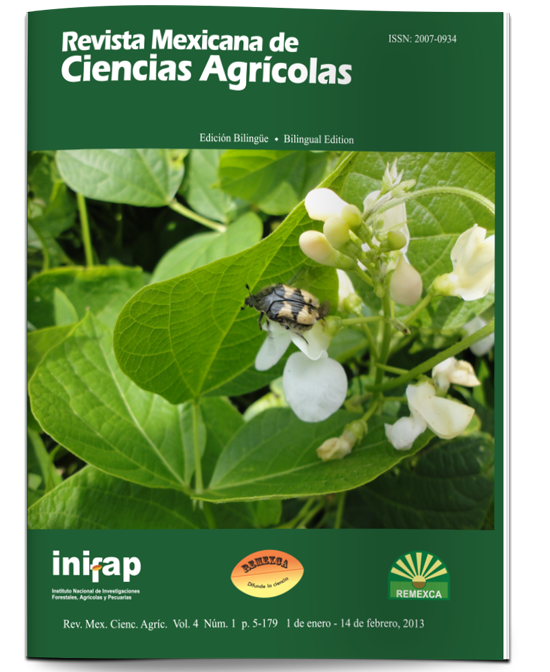Wild beans (Phaseolus vulgaris L.) reaction to planting depth
DOI:
https://doi.org/10.29312/remexca.v4i1.1261Keywords:
domestication, seedling, natural resourcesAbstract
Populations of wild beans (Phaseolus vulgaris L.) are currently used by humans incipiently; many of which are tolerant to environmental stress inducers and their nutritional traits and exceptional quality can therefore represent an untapped resource. The aim of the study was to describe the reaction of wild beans planting depth and contrast it with that of cultivars. The hypothesis was that, as in the wild, wild bean ́s seeds germinate near the soil surface where they are deposited after spontaneous dehiscence of pods as planting depth negatively affects seedling emergence. We used a completely randomized design with factorial arrangement of treatments (15 x 4) under greenhouse conditions. The factors studied were: plant material (six wild genotypes, three traditional cultivars and six improved cultivars) and planting depth (2.5, 5, 7.5 and 10 cm). We also evaluated seed biomass, time for starting and ending the emergence (total or maximum), and emergence percentage initial and maximum. The cumulative emergence wild beans showed logistic trend (y= k/l + [k-n/ne-rx]) as domesticated. Wild beans depth of 2.5 and 10 cm took 1 d more (p≤ 0.05) for the emergency start (7.67 and 9.93 d) compared with the domesticated (6.43 and 2.9 d), but the initial emergence percentage was not different at all (p> 0.05). The maximum emergence was different (p≤ 0.05) by only 10 cm, in which wild beans emerged in a higher proportion (72.78%) than domesticated (59.02%). Planting depth is no disadvantage to the emergence of wild beans.
Downloads
Downloads
Published
How to Cite
Issue
Section
License
The authors who publish in Revista Mexicana de Ciencias Agrícolas accept the following conditions:
In accordance with copyright laws, Revista Mexicana de Ciencias Agrícolas recognizes and respects the authors’ moral right and ownership of property rights which will be transferred to the journal for dissemination in open access. Invariably, all the authors have to sign a letter of transfer of property rights and of originality of the article to Instituto Nacional de Investigaciones Forestales, Agrícolas y Pecuarias (INIFAP) [National Institute of Forestry, Agricultural and Livestock Research]. The author(s) must pay a fee for the reception of articles before proceeding to editorial review.
All the texts published by Revista Mexicana de Ciencias Agrícolas —with no exception— are distributed under a Creative Commons License Attribution-NonCommercial 4.0 International (CC BY-NC 4.0), which allows third parties to use the publication as long as the work’s authorship and its first publication in this journal are mentioned.
The author(s) can enter into independent and additional contractual agreements for the nonexclusive distribution of the version of the article published in Revista Mexicana de Ciencias Agrícolas (for example include it into an institutional repository or publish it in a book) as long as it is clearly and explicitly indicated that the work was published for the first time in Revista Mexicana de Ciencias Agrícolas.
For all the above, the authors shall send the Letter-transfer of Property Rights for the first publication duly filled in and signed by the author(s). This form must be sent as a PDF file to: revista_atm@yahoo.com.mx; cienciasagricola@inifap.gob.mx; remexca2017@gmail.
This work is licensed under a Creative Commons Attribution-Noncommercial 4.0 International license.



